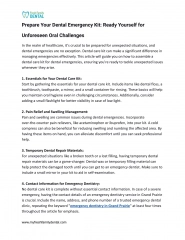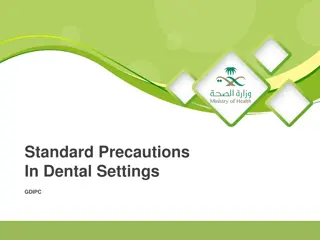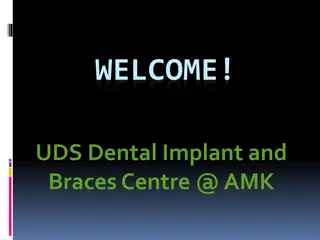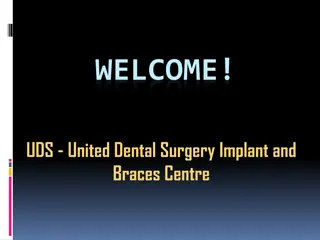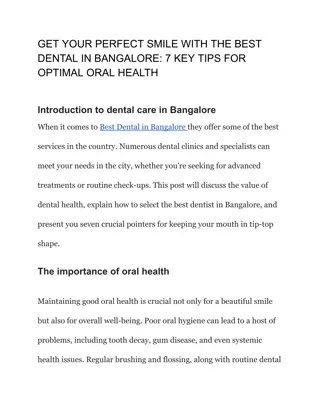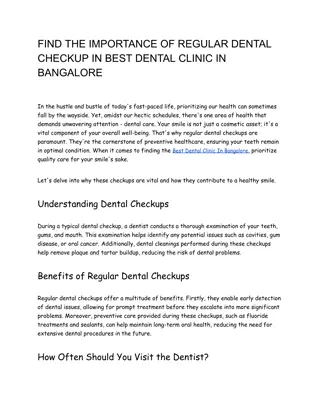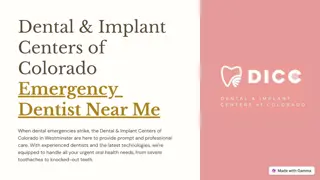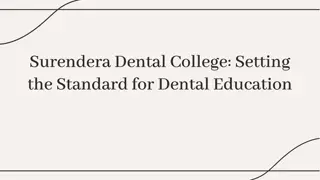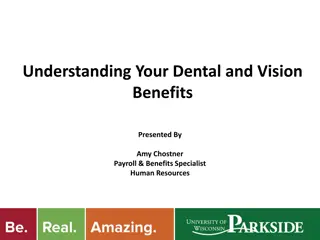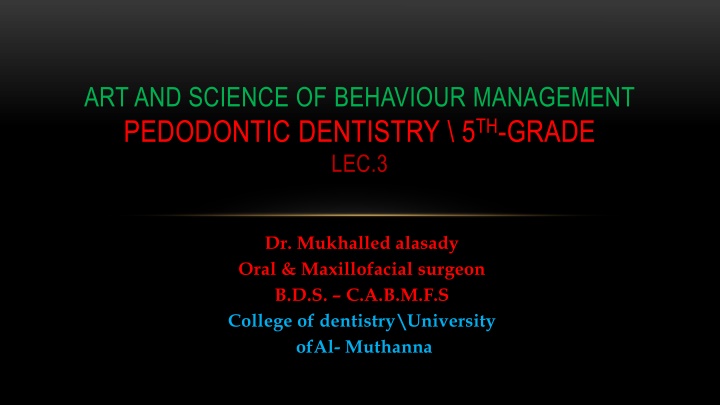
Managing Child Behavior in Pediatric Dentistry: Art and Science Insights
Learn about the art and science of behavior management in pediatric dentistry, focusing on child development, effective communication strategies, and creating a positive dental experience for young patients. Explore the importance of the first dental visit, the pediatric dentistry treatment triangle, and goals of behavior management to establish trust and provide quality care.
Download Presentation

Please find below an Image/Link to download the presentation.
The content on the website is provided AS IS for your information and personal use only. It may not be sold, licensed, or shared on other websites without obtaining consent from the author. If you encounter any issues during the download, it is possible that the publisher has removed the file from their server.
You are allowed to download the files provided on this website for personal or commercial use, subject to the condition that they are used lawfully. All files are the property of their respective owners.
The content on the website is provided AS IS for your information and personal use only. It may not be sold, licensed, or shared on other websites without obtaining consent from the author.
E N D
Presentation Transcript
ART AND SCIENCE OF BEHAVIOUR MANAGEMENT PEDODONTIC DENTISTRY \ 5TH-GRADE LEC.3 Dr. Mukhalled alasady Oral & Maxillofacial surgeon B.D.S. C.A.B.M.F.S College of dentistry\University ofAl- Muthanna
Art and Science of Art and Science of Behaviour Behaviour Management Management
Management of Children Behaviors Behavior: It is an observable act, which can be described in similar ways by more than one person. Child dental management: can be defined as the means by which a course of treatment for a young patient can be completed in the shortest possible period, while at the same time ensuring that he will return for the next course willingly
THE FIRST DENTAL VISIT Should be kept as pleasant and simple as possible An examination and fluoride treatment
The major difference in treating adults & children is in adultsits 1 to 1 relationship. However treating a child is a pedodontic treatment triangle.
Treating a child, however, usually relies on a one-to-two relationship among the dentist, the patient, and parents or caregivers. This relationship, known as the pediatric dentistry treatment triangle. The arrows placed on the lines of communication remind us that communication is reciprocal
The goals of behavior management are: To establish communication with the child and the parents. Alleviate fear and anxiety to provide a relaxing and comfortable environment for the dental team to work in, while treating the child. Deliver quality dental care Build a trusting relationship between dentist, parent and child.
Child development Physical development Physical development is a term used to describe the child s total physical growth and efficiency from the moment of conception until adulthood together. The broad area of physical development involves changes that occur in children s size, strength, motor coordination, functioning of body systems
Social development : It include both interpersonal relationships and independent functioning skills. The change from functional dependency to functional autonomy is a normal process in social development Intellectual development (mental development) : It is a method that employed quantified mental abilities in relation to chronologic age. It led to the concept of the intelligence quotient (IQ). IQ= (mental age/ chronological age) 100
Fear,Anxiety,Phobia -Fear (Apprehension based on history): It is a primal emotion which stems from a recognized source developed to protect the individual from harm e.g. fear of needle ,fight/flight. -Anxiety (Fear of the unknown): It is one of the primary emotions acquired soon after birth. It is a personality trait and is apprehension, tension or uneasiness that stems from anticipation of danger, the source of which is largely unknown or unrecognized e.g. Events which are not pain provoking can be perceived as painful. Phobia (Pathological fear): It is persistent, excessive, unreasonable fear of a specific object, activity or situation, attached to a certain stimulus
Fear: Is a primitive response developing to protect the individual from harm and self destruction , _fear not inherited but it is a primary emotion acquired soon after birth. Types of fear: a)Objective fear: Fear produced by direct physical stimulate of sense organ and are generally not of parental origin like response to stimuli that are felt , seen , heard smelled or tasted and are of unpleasant nature like child with bad dental history.
b)Subjective fear: Fear based on feelings and attitudes that have been suggested to the child by others without having the experience personally like young child experience with dentist hear from others about dental treatment which develop fears. without previous
Value of fear: Fear lowers the threshold of pain so that every pain produced during dental treatment becomes magnified. The child s fears change with age: Two Years Old They are in precooperative stage of lacking cooperative ability. Three Years Old Communication is easier. Child has great desire to talk and often enjoy telling stories. Four Years Old They are usually listeners to explanations with interest and normally responsive to verbal directions. Fears of 4-8 years old Children are related to prior situations and experiences. They begin to anticipate situations and react with fear Fears of 9 years of age Fear is usually associated with personal failures and social peer situations. Child can usually resolve fears of dental procedures if dentist explains and reasons will.
Variables Influencing Childrens Dental Behaviors 1. Major variables (1) Parental anxiety: Children when they are very young, they learn everything from their parents, that is what we called (primary socialization), it lasts for life long, but its effect is reduced when the children go to the school and we call it here (secondary socialization) (2) Past medical history: A child who have had a negative experience associated with medical treatments (a lot of surgeries and a lot of appointments) will be anxious of dental treatment even though they didn't try it, or maybe a negative experience from previous bad dental visit (3) Awareness of a dental problem: Children who know they have a dental problem are more likely to exhibit negative behavior at the first dental appointment
(1) Socio-economic status of the family directly affects child's attitude toward the values of the dental health process. (2) Position of the child in the family (rank of the child): The older child may become more anxious than children born later while middle child is usually more outgoing and suggestible because he use his older sibling and parent as behavior pattern to follow. (3) Child gender: for example boys are expected to be brave stronger than girls (boy act as a man and does not cry). Girls exhibited more dental anxiety and dental behavior management problems than did boys. (4) Child age: There different types of fear at different ages, like in 2-4 years fear of imaginary creatures and small animals then 4-6 years start social and school fear. Fear related to injury, death and so on is shown in those 6 years to adolescent.
Some factors that might contribute to the childs behavior (related to the dentist): 1. Scheduling: Most children are fresher in the morning, and we prefer same age group to be there at the same period, another thing is how much will they wait? 2. Appointment length: new researches suggested to treat each (Quadrant) in each appointment (ex: to treat The 6+E+D at one appointment) creating less numbers of appointments, usually the patient loses his concentration if the appointment is more than 30-45 minutes). 3. Dental Attire: Some Pediatrics have a negative experience toward the white coat and the mask.
Some general consideration of pediatric patients management: 1. Always call the patient by his (first/ nick) name. 2. Direct the conversation toward the child whenever possible. 3. Talk at the child s level (physically and mentally). 4. Avoid quick and sudden movements while performing the procedure. 5. Avoid fear promoting words. 6. Communicate with the patient, but once the treatment starts you need to use short commands. 7. Admire and praise the good behavior, because children like to please adults. 8. Keep self-control all the time, it's not acceptable to lose it, especially while dealing with the pediatric or handicapped patients.


